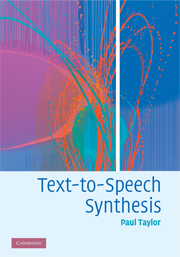Book contents
- Frontmatter
- Contents
- Foreword
- Preface
- 1 Introduction
- 2 Communication and language
- 3 The text-to-speech problem
- 4 Text segmentation and organisation
- 5 Text decoding: finding the words from the text
- 6 Prosody prediction from text
- 7 Phonetics and phonology
- 8 Pronunciation
- 9 Synthesis of prosody
- 10 Signals and filters
- 11 Acoustic models of speech production
- 12 Analysis of speech signals
- 13 Synthesis techniques based on vocal-tract models
- 14 Synthesis by concatenation and signal-processing modification
- 15 Hidden-Markov-model synthesis
- 16 Unit-selection synthesis
- 17 Further issues
- 18 Conclusion
- Appendix A Probability
- Appendix B Phone definitions
- References
- Index
16 - Unit-selection synthesis
Published online by Cambridge University Press: 25 January 2011
- Frontmatter
- Contents
- Foreword
- Preface
- 1 Introduction
- 2 Communication and language
- 3 The text-to-speech problem
- 4 Text segmentation and organisation
- 5 Text decoding: finding the words from the text
- 6 Prosody prediction from text
- 7 Phonetics and phonology
- 8 Pronunciation
- 9 Synthesis of prosody
- 10 Signals and filters
- 11 Acoustic models of speech production
- 12 Analysis of speech signals
- 13 Synthesis techniques based on vocal-tract models
- 14 Synthesis by concatenation and signal-processing modification
- 15 Hidden-Markov-model synthesis
- 16 Unit-selection synthesis
- 17 Further issues
- 18 Conclusion
- Appendix A Probability
- Appendix B Phone definitions
- References
- Index
Summary
We now turn to unit-selection synthesis which is the dominant synthesis technique in text-to-speech today. Unit selection is the natural extension of second-generation concatenative systems, and deals with the issues of how to manage large numbers of units, how to extend prosody beyond just F0 and timing control, and how to alleviate the distortions caused by signal processing.
From concatenative synthesis to unit selection
The main progression from first- to second-generation systems was a move away from fully explicit synthesis models. Of the first-generation techniques, classical LP synthesis differs from formant synthesis in that it uses data, rather than rules, to specify vocal-tract behaviour. Both first-generation techniques, however, still used explicit source models. The improved quality of second-generation techniques stems largely from abandoning explicit source models as well, regardless of whether TD-PSOLA (no model), RELP (use of real residuals) or a sinusoidal model (no strict source/filter model) is employed. The direction of progress is therefore clear: a movement away from explicit, hand-written rules, towards implicit, data-driven techniques.
By the early 1990s, a typical second-generation system was a concatenative diphone system in which the pitch and timing of the original waveforms were modified by a signal-processing technique to match the pitch and timing of the specification. In these second-generation systems, the assumption is that the specification from the text-analysis system comprises a list of items as before, where each item is specified with phonetic/phonemic identity information, a pitch and a timing value. Hence, these systems assume the following.
- Type
- Chapter
- Information
- Text-to-Speech Synthesis , pp. 474 - 516Publisher: Cambridge University PressPrint publication year: 2009



